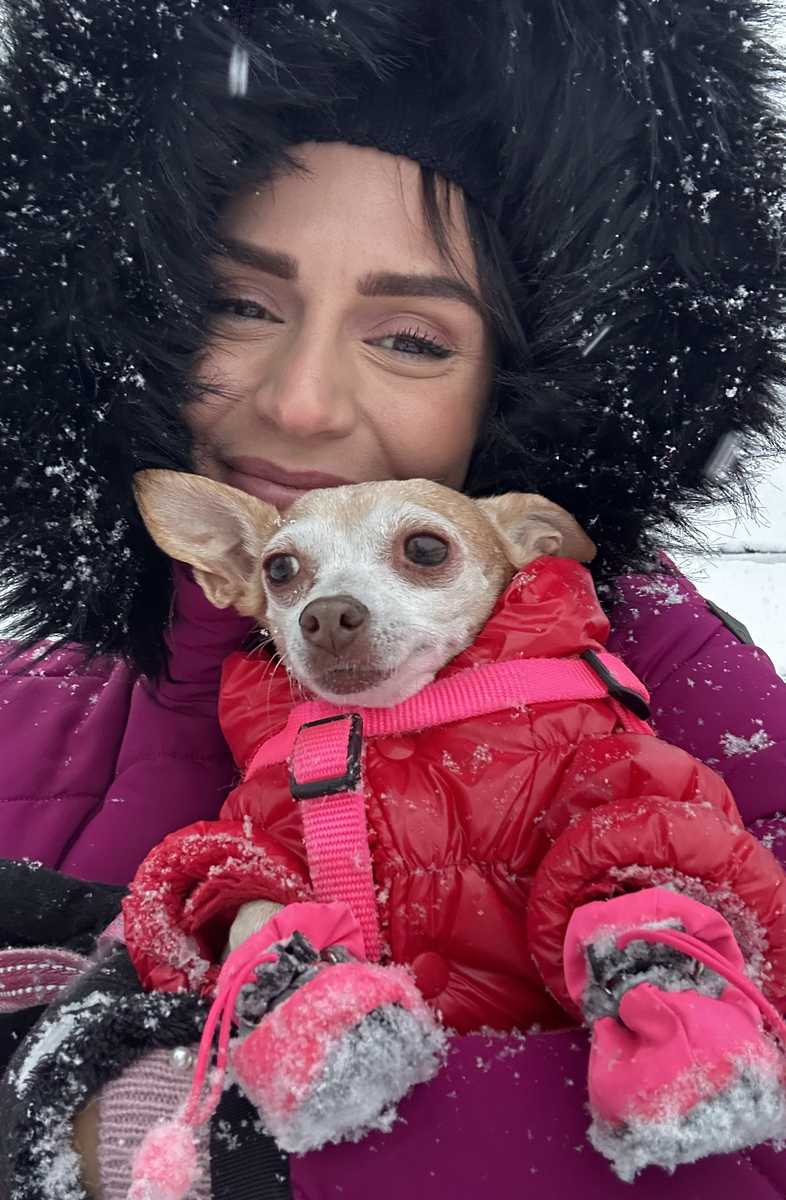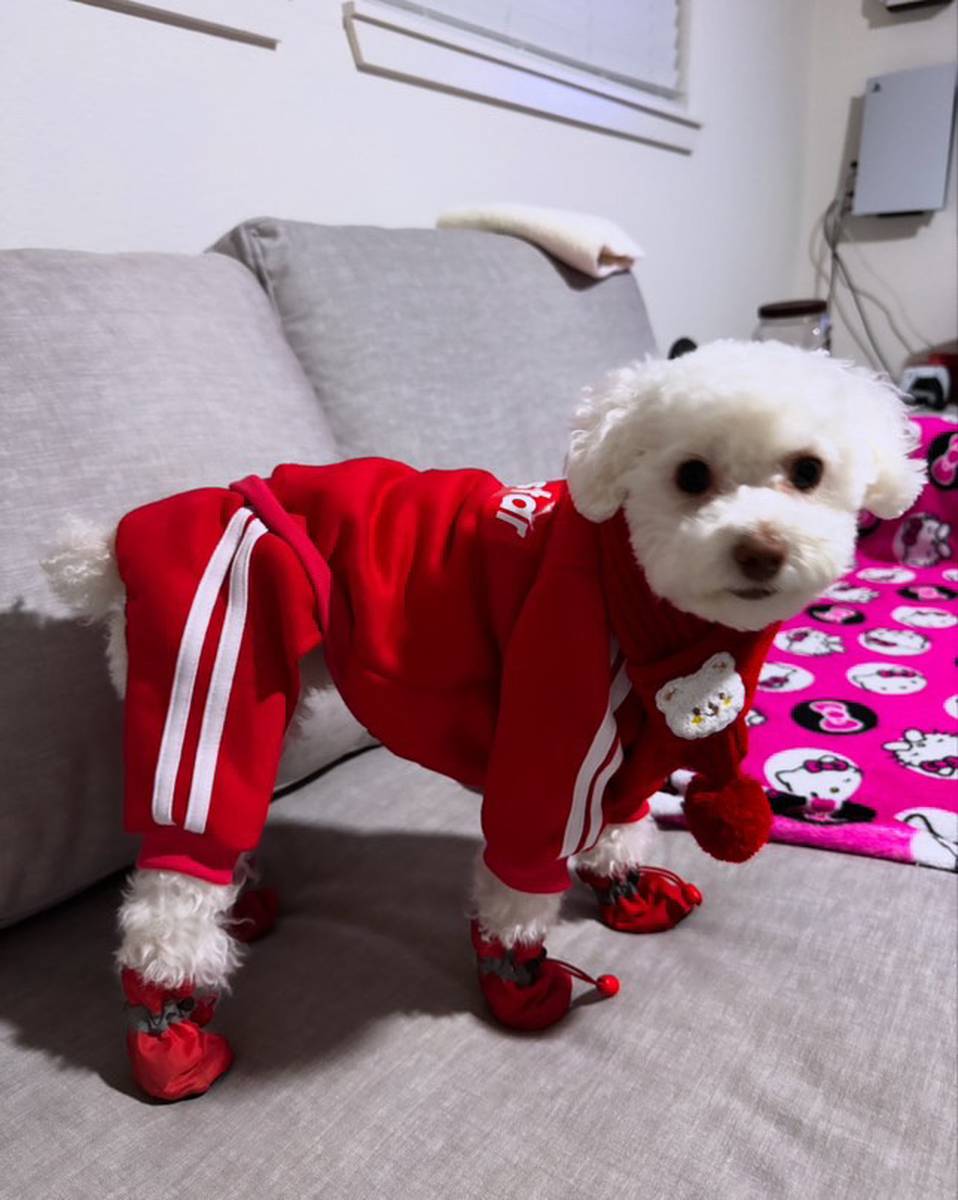
Mara Peverini and Layla playing in the snow.
11:24 JST, December 26, 2024
It’s 30 degrees in Grand Rapids, Michigan, and Mara Peverini is getting ready to head out the door. She bundles up in a sweater, a puffer jacket, boots and a scarf.
Then she does the same for her dog.
“She can spend an hour outside in the snow, as long as she’s dressed properly,” Peverini, 31, said of her 10-year-old Chihuahua, Layla. “But the moment I underdress her, we walk five feet and she refuses to keep going.”
“We alternate with the colors and styles,” Peverini said.
Winter outerwear has become increasingly popular for pets. Clothing brands for humans have started selling doggy lines, and pet parents are wearing matching parkas with their pooches.
While it’s adorable, and sometimes hilarious, for canines to wear winter clothes, it’s actually important for many dogs to keep them safe in cold weather, experts say.
“There are several factors that go into whether a dog needs winter protection,” said Nancy Kay, a veterinarian and author of “Speaking for Spot.”
Key factors include climate, breed, age, size, health and hair coat.
“Any of the arctic breeds – Siberian huskies, malamutes, Samoyeds – those are dogs that were bred for snow, and so they really don’t need protection,” Kay said. “If you picture the opposite end, like a whippet, with skinny legs and a light hair coat, those dogs definitely need protection.”
When humans domesticated wolves about 40,000 years ago, they did not need people to wrap them in parkas to keep them warm. But over the centuries, as they evolved into various breeds of dogs that live inside, many have lost their natural thick fur that protects them from the elements.
“Dogs have changed,” said Kay, adding that breeds that are vulnerable to the cold have become more popular in recent years.
If a dog is going outside to relieve themselves, they don’t need protective gear, Kay said, but it’s important to protect them if they’re spending stretches of time in the cold.
“A common misconception is that dogs have hair coats and that they’re never going to be bothered by the cold,” Kay said. “That’s not true at all.”
A rule of thumb, she said, is that larger breeds are generally less likely to need winter clothing, but smaller breeds have a harder time regulating their body temperature and should wear warm layers and booties, especially if they live in places where temperatures dip below freezing.
Age and health are also considerations.
“A dog that’s more fragile because of age or illness, that, too, is a reason to put a coat on,” Kay said. “Know your animal and know your environment.”
Even in relatively mild climates, dogs can get too cold. Signs to look out for if your dog is chilly include apprehension about going for a walk.
“Shivering is a good indicator,” Kay said.
Lori Bierbrier, senior medical director of community medicine at the American Society for the Prevention of Cruelty to Animals, said dogs are vulnerable to hypothermia if they’re too exposed to cold weather.
“If it is too cold for you, it’s too cold for your pet,” she said.

Okja wearing a tracksuit, boots and a scarf.
Okja, a 4-year-old Maltipoo in Lathrop, California, seldom steps outside in the winter without a jacket and boots.
“She’s a small dog, so she does shiver when we are outside,” said her parent, Danira Kucevic, 31.
Wearing winter clothes “makes her more comfortable,” Kucevic said.
Alvaro Millan, 42, takes a similar approach with his two dogs – Archie, a 3-year-old mini goldendoodle, and Amaya, a 1-year-old toy poodle.
When temperatures in San Jose, where they live, recently dipped to 37 degrees, Millan dressed his dogs in warm hoodies and boots.
“That morning it was too cold. I could see they were shaking,” Millan said.
In the world of pet winter gear, though, experts say the boundaries between fashion and function have somewhat blurred – the global pet-clothing market size was valued at $5.56 billion last year.
Before dressing their dog, owners should consider: “Are you putting it on for the dog’s sake or your sake?” Kay said. “I think some people do it as more of a fashion statement than anything else.”
Han Xia, who lives in Hoboken, N.J., with her 3-year-old miniature dachshund, Kiki, said her pup has three winter coats, as well as dozens of sweaters.
“If it’s cold outside, she doesn’t want to go out without clothes,” said Xia, 32.

Kiki wearing a light winter coat.
When Xia got Kiki a few years ago and took her outside on a winter walk, “she was shaking uncontrollably, and we realized she’s really cold.”
Although the winter gear keeps Kiki warm, Xia said she enjoys leaning into the fashion and fun of it.
“If I’m going to buy clothes for Kiki anyway, I might as well get cute ones,” she said.
Devon Boone, 34, also delights in dressing his 4-year-old Doberman pinscher, Cru.
“It’s fun to see him dress up in different sweaters and be festive,” Boone said.

Cru in his winter gear.
While the weather is mostly mild in San Diego, where they live, Cru still wears sweaters. For a trip to Yosemite two years ago, Boone bought Cru a puffer jacket and boots.
Alisha Bobczynski recently bought Ocean, her 1-year-old American bully-American Staffordshire terrier mix, a pearly pink winter coat from the trendy retailer Aritzia to match her own jacket.
“I think I get more satisfaction out of buying clothes for her than I do buying clothes for myself,” said Bobczynski, who lives in Calgary, Alberta, where winters are frigid. The average temperature in January is a low of 12 degrees and a high of 30.
Bobczynski, 33, said she is certain her pup prefers to wear a coat on cold days, because if she goes out without one, “she’ll turn around and drag me back home.”

Ocean in her pink puffer coat.
Like many dogs, Ocean is not a fan of boots – which keep paws warm in cold weather and prevent salt and harsh chemicals from irritating them.
When it comes to selecting winter protection for dogs, fit is an important factor.
“A jacket that doesn’t fit properly may be uncomfortable and may cause irritation to the dog’s skin,” said Bierbrier, adding that winter coats should always be waterproof. “Make sure the winter gear does not limit their movement, sight or ability to breathe or bark.”
Training is helpful, too.
“The training component is one of the important pieces that often gets overlooked,” said Sassafras Patterdale, a dog trainer in Portland, Ore.
Patterdale – author of “Tricks in the City” – recommends introducing dogs to winter gear slowly before they need to wear it and letting them explore it. Offer treats, too.
“Repeat that over several training sessions … [and] very slowly start to increase the time that your dog is wearing the winter gear,” Patterdale advised.
Above all, owners should – to the best of their ability – try to tune in to what their dog is comfortable with.
“Dogs don’t speak human, but they do speak to us,” Kay said. “We just have to pay attention.”
"News Services" POPULAR ARTICLE
-

American Playwright Jeremy O. Harris Arrested in Japan on Alleged Drug Smuggling
-

Japan’s Nikkei Stock Average as JGB Yields, Yen Rise on Rate-Hike Bets
-

Japan’s Nikkei Stock Average Licks Wounds after Selloff Sparked by BOJ Hike Bets (UPDATE 1)
-

Japanese Bond Yields Zoom, Stocks Slide as Rate Hike Looms
-

Japan’s Nikkei Stock Average Buoyed by Stable Yen; SoftBank’s Slide Caps Gains (UPDATE 1)
JN ACCESS RANKING
-

Keidanren Chairman Yoshinobu Tsutsui Visits Kashiwazaki-Kariwa Nuclear Power Plant; Inspects New Emergency Safety System
-

Imports of Rare Earths from China Facing Delays, May Be Caused by Deterioration of Japan-China Relations
-

University of Tokyo Professor Discusses Japanese Economic Security in Interview Ahead of Forum
-

Japan Pulls out of Vietnam Nuclear Project, Complicating Hanoi’s Power Plans
-

Govt Aims to Expand NISA Program Lineup, Abolish Age Restriction
























